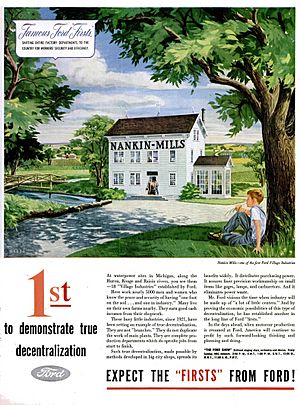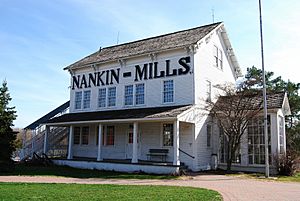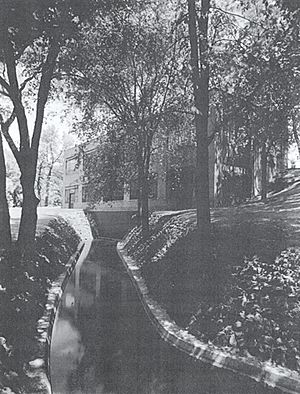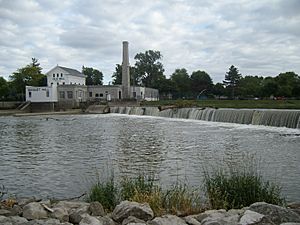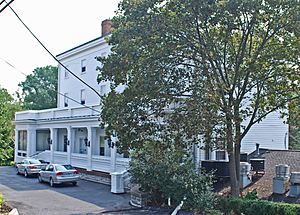Village industries facts for kids
Henry Ford's Village Industries were small factories built by Henry Ford in the countryside of Michigan. Ford created these factories to help farm workers earn money, especially during the winter when they couldn't farm. He wanted to give them a steady income all year round.
Contents
- Why Ford Built These Factories
- History of Ford's Village Factories
- List of Village Factory Sites
- Northville Valve Factory
- Nankin Mills Factory
- Phoenix Mill Factory
- Flat Rock Lamp Factory
- Plymouth Tool Factory
- Waterford Gauge Factory
- Ypsilanti Parts Factory
- Newburgh Drill Factory
- Hayden Mills Soybean Factory
- Dundee Foundry
- Milan Ignition Coil Factory
- Milford Carburetor Factory
- Saline Soybean Plant
- Brooklyn Parts Factory
- Sharon Mills Factory
- Manchester Instrument Factory
- Willow Run Locks Factory
- Clarkston Parts Factory
- Cherry Hill Locks Factory
Why Ford Built These Factories
Ford really liked country life. But he saw that young people were leaving farms to find better-paying jobs in cities. Factories, including his own, were making farming less popular and leaving farmers with less to do in the cold months.
Ford's idea was to bring factory jobs to rural areas. This way, people could earn good money without leaving their farming traditions. He wanted to make rural communities stronger by giving jobs to local people who didn't have enough work. Farmers could work in the factories in winter and go back to their farms in summer. Ford also hoped to keep the peaceful country lifestyle he remembered from his childhood.
He wanted technology, factories, and farming to work together. He chose rural spots near farms for his village industries. These small factories were an important part of his bigger manufacturing system, making parts that were cheap and reliable. To save on transportation costs, Ford picked locations close to his larger factories, like the Ford River Rouge Complex and the Highland Park Ford Plant. The parts made in these village factories were small and light, so they were easy to ship.
Ford also believed in using clean energy. He thought water power was almost endless and easy to find in Michigan. He had even used water power at his own home, Fair Lane. So, all the village industry plants used hydroelectric power. Many were built where old mills used to be. Some even used the old mill buildings, while others were new factories built on the mill sites.
History of Ford's Village Factories
After World War I, Henry Ford started to spread out his factories, moving some production away from Detroit and Dearborn, Michigan. He thought it was better to manage smaller groups of workers in different places. This plan included building small rural factories called "village industries." These factories took specific tasks from bigger plants and moved them to the countryside.
In 1918, Ford bought his first village industry site: Nankin Mills on the Rouge River. Ford knew this place because he had visited it as a boy with his father to grind grain. In 1919, he bought a second old mill in Northville, Michigan, a place where he had spent his honeymoon. Ford planned to build more sites. He made a deal with the Wayne County Road Commission: they would build dams for water power along the Rouge River for Ford, and in return, they would get the land and eventually the mills. Ford ended up building six village industries along the Rouge River.
Ford turned the Northville property into a factory that made valves. He moved machines from his Fordson and Highland Park factories. The Ford Valve Plant in Northville was the first village industry to open, in 1919-1920. Meanwhile, Nankin Mills became a small factory, and in 1920, workers there started making screws.
More factories opened quickly. By 1925, there were three more village industries in Phoenix, Plymouth, and Waterford. After a short break, only two new plants opened in the next ten years, in Flat Rock and Ypsilanti. But in the late 1930s and early 1940s, Ford quickly expanded the idea. He opened plants in Tecumseh, Newburg, Dundee, Brooklyn, Saline, Milan, Milford, Sharon Hollow, Willow Run, and Manchester. Many of these factories opened during the Great Depression and greatly helped their communities by employing many people who would otherwise have been jobless. During World War II, three more plants were built at Hayden Mills, Cherry Hill, and Clarkston.
However, the village industry program didn't last much longer than Henry Ford himself. The small factories weren't making enough money. After Henry Ford stepped down in 1945, the company started closing them because they weren't as profitable as larger plants. Most were closed in the 1940s. Only five were still open in the mid-1950s, and only three in the mid-1960s. Just one, the Ford Valve Plant in Northville, was still running in the mid-1970s. This Northville plant, which was both the first and last of Ford's village industries, finally closed in 1981.
List of Village Factory Sites
There isn't one official list of all the village industry sites. It's sometimes hard to tell if a small factory was part of the "village industry" program or just a regular small factory. Ford Motor Company says there were "more than 30 Village Industries plants" in different states. However, many historians focus on the 18 or 20 sites in southern Michigan that Ford mostly built in the 1920s and 1930s. The following list includes 19 sites that many historians agree on.
Northville Valve Factory
42°25′56″N 83°28′40″W / 42.43222°N 83.47778°W The Northville factory is at 235 East Main Street in Northville, Michigan. This spot was first home to a gristmill (a mill for grinding grain) built in 1825. Henry Ford bought this old mill in 1919.
He turned the mill into a factory that made valves for cars. He moved machines from his other plants to Northville. It opened in 1920 as the first village industry. Between 1920 and 1936, this factory made over 180 million valves. They cost less than half what they would have cost to make in the larger Highland Park plant.
In 1936, Ford replaced the old mill with a new factory building designed by Albert Kahn. This new building looked modern for its time and even had a water wheel. Up to 400 people worked at the Northville plant. It kept making valves even after the Village Industries program ended in 1947. The building was made bigger in 1956. By 1969, it produced over 150,000 valves every day! The plant kept working until 1981, making it the longest-running of all Ford's village factories. It briefly reopened in 1982 to make shipping racks and gas tanks but closed for good in 1989.
The building was later sold and is now used as office space for design companies. The land around it is a town park, which includes "Mill Race Village," an outdoor museum with old restored buildings. The valve plant was added to the National Register of Historic Places in 1995.
Nankin Mills Factory
42°20′55″N 83°22′10″W / 42.34861°N 83.36944°W The Nankin Mills site is at 33175 Ann Arbor Trail in Westland, Michigan. The first mill here was built between 1835 and 1842 but burned down during the American Civil War. A second mill was built in 1863.
Henry Ford bought this mill in 1918. He turned it into a small factory. In 1920, twelve workers started making screws for Ford. It was the second village industry to open. In 1927, Ford changed the factory to make engravings and stencils. A new building was added in 1937. Eventually, about 70 people worked here.
The plant closed in 1948. Ford then gave the site to the Wayne County Road Commission. They updated the mill, and in 1956, it opened as a nature center. It became a Michigan State Historic Site in 1967. In the mid-1980s, Nankin Mills became the main office for the Wayne County Park System. An addition was built in 1999, and in 2001, the original mill reopened as a learning center.
Phoenix Mill Factory
42°23′33″N 83°28′1″W / 42.39250°N 83.46694°W The Phoenix Mill is on the Rouge River, at 14973 Northville Road in Plymouth Township. This was once the village of Phoenix, founded in 1837. The mill here was built in 1840 but burned down in 1905.
Ford bought the mill site in 1919. He hired Albert Kahn to design a new factory. The factory was built, but its opening was delayed when the mill dam broke in 1921. It finally opened in 1922. This factory was special because it only employed women workers from Ford's Highland Park plant. Ford paid these women high wages, the same as male workers, which was very rare in the 1920s. However, the women had to be single and childless, and dress formally in dresses, stockings, and heels.
At its busiest, 148 women worked at the Phoenix Mill. It first made generator cutouts. In 1940, it switched to making voltage regulators for V8 engines. During World War II, the plant made parts for B-24 bombers. The Phoenix Mill plant closed in 1948. Ford gave it to the Wayne County Road Commission, who used it for maintenance. It became a Michigan State Historic Site in 1989.
Flat Rock Lamp Factory
42°5′55″N 83°17′55″W / 42.09861°N 83.29861°W The Flat Rock factory was built where an old sawmill used to be in Flat Rock, Michigan. Ford bought the land in 1921 and hired Albert Kahn to design the building. The factory opened in 1923. It employed as many as 1200 people and made all the vehicle lamps used by Ford.
The Flat Rock site closed in 1950, and its production moved to a nearby factory in Monroe, Michigan. The site is now used by smaller private manufacturing companies. The land around it has been turned into a park.
Plymouth Tool Factory
42°23′1″N 83°27′30″W / 42.38361°N 83.45833°W The Plymouth Mills site is at 230 Wilcox in Plymouth, Michigan. A flour mill was built here in 1845. It was called Wilcox Mills by 1879 and operated as a gristmill until Henry Ford bought it and tore it down.
Ford hired Albert Kahn to design a new building. This new village industry opened in 1923. It employed up to 23 people making taps and other tools used in manufacturing. The Plymouth site closed in 1948. The building was given to the Wayne County Parks division, who used it as a garage. It became a Michigan State Historic Site in 1989. As of 2005, it is an artist's studio.
Waterford Gauge Factory
42°24′21″N 83°28′5″W / 42.40583°N 83.46806°W The Waterford factory is at 16580 Northville Road in Northville, Michigan. This area was originally a village called Mead's Mill. In 1873, it was renamed "Waterford." A gristmill was built here.
In 1925, Ford bought the gristmill site and its dam. A new building was designed and opened in 1925. The factory employed up to 210 people making precision gauges (tools for measuring). These workers were moved from New Jersey after Ford bought another company there. The Waterford site closed in 1954. As of 2005, a window manufacturer owns the building.
Ypsilanti Parts Factory
42°13′54″N 83°36′26″W / 42.23167°N 83.60722°W The Ypsilanti factory was in a building designed by Albert Kahn on the Huron River in Ypsilanti, Michigan. A hydroelectric power plant was built nearby in Rawsonville. The Ypsilanti factory opened in 1932. It later merged with a larger Ford facility in 1947. After the merger, it employed 1500 people, making it the biggest of all the village industries. This factory made all the starters and generators for the Ford Motor Company. It eventually became part of a more traditional factory. In 1969, the Rawsonville hydroelectric plant, dam, and surrounding land were given to the city of Ypsilanti.
Newburgh Drill Factory
42°22′0″N 83°24′40″W / 42.36667°N 83.41111°W The Newburgh mill is at 37401 Edward N. Hines Drive in Livonia, Michigan. In 1870, someone built a dam here and a cider mill. The lake created was called "Newburgh Lake," and the village of Newburgh grew around it.
In 1934, Ford bought the cider mill site. A new building was designed and built with help from Ford, the Wayne County Road Commission, and the New Deal's Works Progress Administration (a government program to create jobs). The new factory opened in 1935. It employed up to 32 people making twist drills. During World War II, it also made aircraft parts.
The Newburgh site closed in 1948. The building was given to the Wayne County Parks division, who used it for maintenance and law enforcement. It became a Michigan State Historic Site in 1989. As of 2005, the building has been updated for public use.
Hayden Mills Soybean Factory
42°0′14″N 83°56′2″W / 42.00389°N 83.93389°W The Hayden Mills site is at 703 East Chicago Street in Tecumseh, Michigan. This was originally the Globe Mill, a flour mill built in the 1830s. It later became Hayden Mills. In 1898, the original mill burned, and a new one replaced it. An electric power plant was added later.
Ford bought the mill from Hayden's family. He rebuilt the mill and opened the factory in 1935. It employed up to 25 people processing soybeans. The site closed in 1948. It was later used as a private gun club. In 1961, it was given to the city of Tecumseh, who used it as a Community Center.
Dundee Foundry
41°57′20″N 83°39′33″W / 41.95556°N 83.65917°W The Dundee mill, also known as the Alfred Wilkerson Grist Mill, is at 242 Toledo Street in Dundee, Michigan. A sawmill was first built here in 1828. In 1848-1849, a gristmill was built. In the 1920s, the mill site was abandoned.
In 1931, the village planned to tear down the building, but Henry Ford bought it instead. He had been thinking about buying it since 1922. In 1935, Ford started fixing up the mill and built some new buildings. The factory opened in 1936 as a foundry that worked with copper alloys, mainly making copper welding tips. It employed up to 125 people.
The Dundee site closed in 1954. It was later bought by a company that used it until 1970. Then, they sold the mill to the village of Dundee for just $1.00. The site was empty for ten years until 1981, when restoration began. The village turned the mill into offices, a community center, and a museum, which opened in 1986. It became a Michigan State Historic Site in 1979 and was added to the National Register of Historic Places in 1990.
Milan Ignition Coil Factory
42°4′52″N 83°41′3″W / 42.08111°N 83.68417°W The Milan site is at 147 Wabash Street in Milan, Michigan. Ford bought an existing mill in Milan in 1936. The mill was updated, including a new dam and hydroelectric plant. The mill processed soybeans, and a small factory on site made ignition coils. By 1939, the mill had almost 200 employees and made all the ignition coils for the Ford Motor Company. The factory continued making ignition coils through World War II but closed in 1948. Its production and employees moved to the nearby Ypsilanti plant. The property was given to the village of Milan, who used it for offices, the police department, and a library.
Milford Carburetor Factory
42°35′23″N 83°36′8″W / 42.58972°N 83.60222°W The remaining building from the Milford site is near a mill pond at 225 West Liberty in Milford, Michigan. The Upper Mill Pond was created by a dam in 1845. Early in the 20th century, a factory called Detroit Auto Dash was built nearby.
Ford bought the Auto Dash factory and nearby land. In 1938, he opened a plant there, officially called the "Pettibone Creek Hydroelectric Station." This plant had two hydroelectric powerhouses and a manufacturing facility. It was designed by Albert Kahn. The Milford site made carburetors. It could initially make 2,450 carburetors per day. After updates in 1945, it could make 3,200 per day.
The Milford factory stayed open until 1957, when its production moved to a plant in Rawsonville. The old Auto Dash factory was sold to Kelsey-Hayes. The Huron River Hydroelectric Station was torn down in 1997, and the carburetor factory followed in 2001. The last remaining building, the Pettibone Creek Hydroelectric Station (also known as the "Milford Powerhouse"), has been restored. It was added to the National Register of Historic Places in 2000.
Saline Soybean Plant
42°9′46″N 83°47′23″W / 42.16278°N 83.78972°W The Saline factory, also known as the Schuyler Mill, is at 555-600 Michigan Avenue in Saline, Michigan. In 1845, David Schuyler Haywood built a gristmill here. A small settlement grew around it, which later became part of Saline. However, by 1865, business slowed, and the mill closed.
Henry Ford bought the site in 1936. He fixed it up and opened it as a soybean processing plant in 1938. It employed up to 19 people. They removed soybean oil from the beans, which was used to make plastics and paint. The leftover parts were used for casting or cattle feed. In 1943, Ford moved a one-room schoolhouse to the site and turned it into a home. However, the plant closed in 1947, not long after Henry Ford died.
After it closed, a private company used the building for soybean processing. But the equipment soon became old. In 1962, the property became an antique shop and general store. More recently, part of the building has been used as a cafe and a place for events. The mill was added to the National Register of Historic Places in 1996.
Brooklyn Parts Factory
42°6′37″N 84°14′44″W / 42.11028°N 84.24556°W The Brooklyn mill is at 221 Mill Street in Brooklyn, Michigan. A gristmill was first built here around 1832. The small village that grew around it was first called Swainsville, but in 1836, its name changed to Brooklyn. The Brooklyn Mill burned down around 1912.
Henry Ford bought the property in 1921 but didn't use it for a while. Eventually, he built a new factory here, which opened in 1939. It employed up to 130 people making horn buttons and starter switches for cars. During World War II, it switched to making brass spark plug bushings for B-24 bombers. After the war, it went back to making horn buttons and starter switches until 1954. Then, it started making armrests and lamp lenses.
The Brooklyn site closed in 1967. After it closed, the building was owned by different companies. It has recently been used to store a collection of Model T cars. In 2014, Daniel and Samantha Ross bought the building and are turning it into an Irish-themed place called the Old Irish Mill.
Sharon Mills Factory
42°10′38″N 84°5′30″W / 42.17722°N 84.09167°W The Sharon Mills (or Sharon Hollow) factory is at 5701 Sharon Hollow Road in Sharon, Michigan. In the 1830s, a sawmill was built here. Later, a gristmill was built and operated until the 1920s.
Henry Ford bought the property in 1926. He restored the beautiful Greek Revival style mill and added a wing and a hydroelectric generator. The factory opened in 1939. It employed up to 19 people making cigarette lighters, ammeters, and switches for cars.
The Sharon Mills site closed in 1947. After it closed, the building was mostly used as a private home, and for a short time, an antique shop. In the 1990s, it was a winery. In 1999, the Washtenaw County Park Division bought the property to use as a museum and conference center. The county restored the mill, and it is now Sharon Mills Park. It became a Michigan State Historic Site in 1989.
Manchester Instrument Factory
42°9′0″N 84°1′26″W / 42.15000°N 84.02389°W The Manchester factory was built where an old (1892) gristmill used to be, east of town on Austin Road.
Ford bought the site in 1936 and spent a lot of money fixing it up and adding equipment. The factory opened in 1941. It employed up to 279 people making ammeters, gauges, and instrument clusters for cars.
The Manchester site closed in 1957. In 1960, the factory was sold to a small manufacturer. It was later owned by several other manufacturing companies. In 2001, the property was sold to the village of Manchester. The village now uses the site for its public library and village offices.
Willow Run Locks Factory
42°14′3″N 83°33′0″W / 42.23417°N 83.55000°W The Willow Run factory opened in 1940 in a new building. It was open for a short time, employing up to 41 people making ignition locks, door locks, and keys. It closed in 1944. The building has been empty for a long time.
Clarkston Parts Factory
42°44′10″N 83°25′12″W / 42.73611°N 83.42000°W The Clarkston site is at 20 West Washington Street in Clarkston, Michigan. A sawmill was built here in 1833. The mill changed owners several times and was torn down in 1917. In 1920, the Fords bought the property.
The land was empty for a while. In 1941, Ford started building a factory on the old mill site. The plant opened in 1942, with up to 40 people making drill bushings, straps, and seat covers. However, it was open for a short time and closed in 1947.
In 1950, a company bought the building. It was later used by other companies and then sat empty. In the 1970s, the property was turned into a small shopping mall. Later, much of the space became offices. The site is part of the Clarkston Village Historic District, which is a Michigan historic site and listed on the National Register of Historic Places.
Cherry Hill Locks Factory
42°18′20″N 83°32′20″W / 42.30556°N 83.53889°W The Cherry Hill factory was at the corner of Cherry Hill and Ridge Roads in the village of Cherry Hill, Michigan. This area was settled in 1825. An inn was built here around 1865, named the "Cherry Hill House" because of the wild cherry trees. A dairy was also located here.
Henry Ford bought the dairy around 1940. He turned it into another village industry, which opened in 1944. It employed 30 people making ignition locks, door locks, keys, and brass petcocks. This factory was special because part of its goal was to provide work for World War II veterans who had physical or mental disabilities from their service. The plant closed in 1950.
The building now houses private manufacturing facilities. The property is currently owned by The Partnership for Arts and Humanities (Canton), who hope to fix it up and make it useful again, keeping some of Henry Ford's ideas in mind. The site was added to the National Register of Historic Places as part of the Cherry Hill Historic District in 2003.
|


